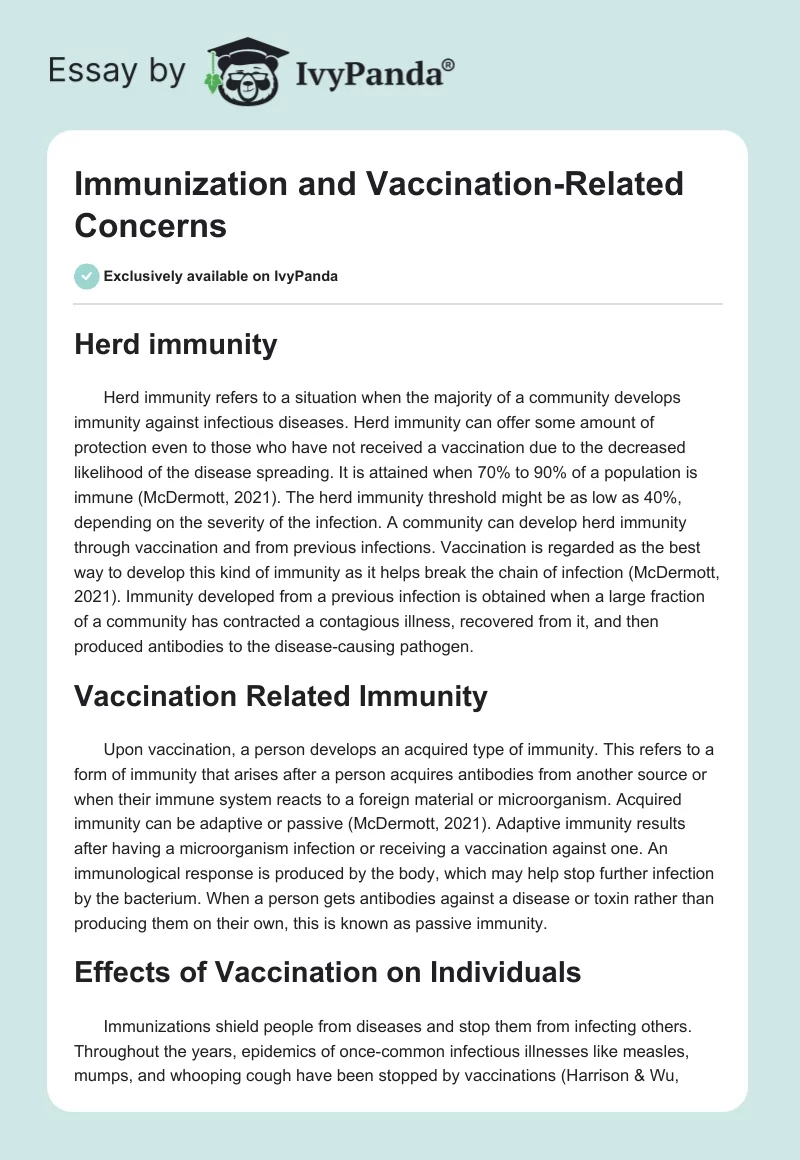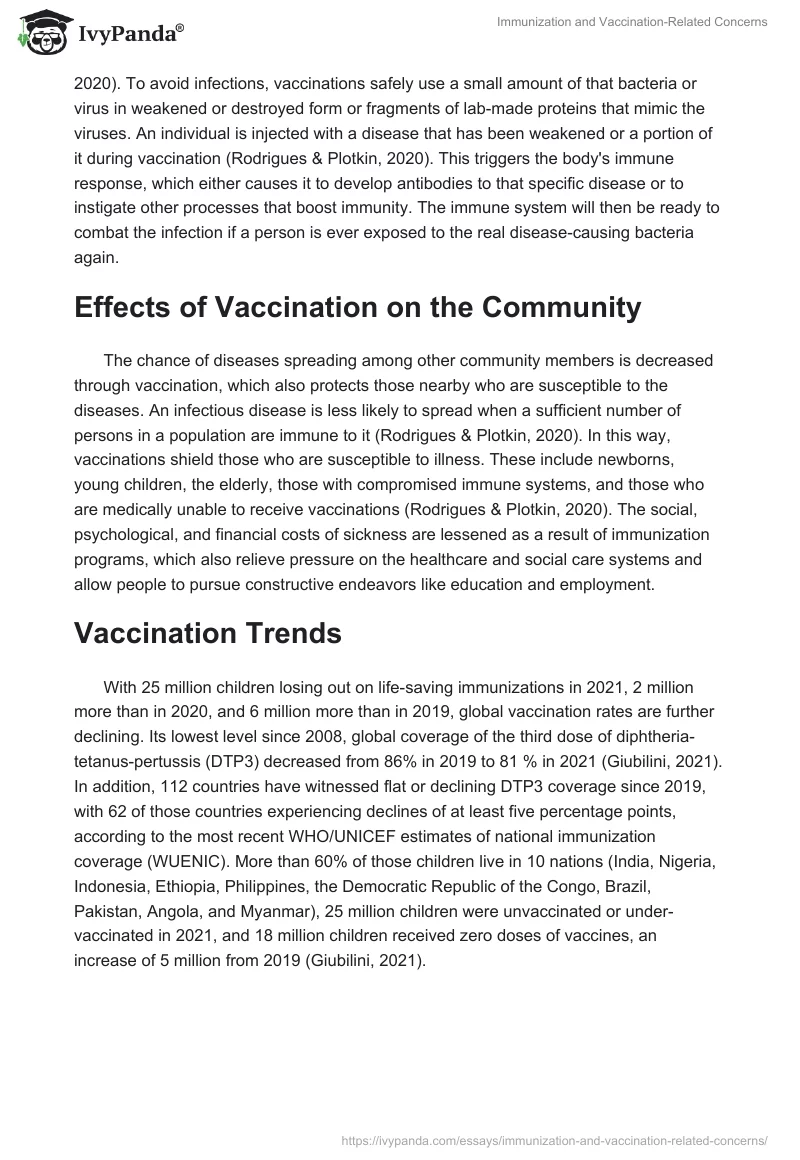Herd immunity
Herd immunity refers to a situation when the majority of a community develops immunity against infectious diseases. Herd immunity can offer some amount of protection even to those who have not received a vaccination due to the decreased likelihood of the disease spreading. It is attained when 70% to 90% of a population is immune (McDermott, 2021). The herd immunity threshold might be as low as 40%, depending on the severity of the infection. A community can develop herd immunity through vaccination and from previous infections. Vaccination is regarded as the best way to develop this kind of immunity as it helps break the chain of infection (McDermott, 2021). Immunity developed from a previous infection is obtained when a large fraction of a community has contracted a contagious illness, recovered from it, and then produced antibodies to the disease-causing pathogen.
Vaccination Related Immunity
Upon vaccination, a person develops an acquired type of immunity. This refers to a form of immunity that arises after a person acquires antibodies from another source or when their immune system reacts to a foreign material or microorganism. Acquired immunity can be adaptive or passive (McDermott, 2021). Adaptive immunity results after having a microorganism infection or receiving a vaccination against one. An immunological response is produced by the body, which may help stop further infection by the bacterium. When a person gets antibodies against a disease or toxin rather than producing them on their own, this is known as passive immunity.
Effects of Vaccination on Individuals
Immunizations shield people from diseases and stop them from infecting others. Throughout the years, epidemics of once-common infectious illnesses like measles, mumps, and whooping cough have been stopped by vaccinations (Harrison & Wu, 2020). To avoid infections, vaccinations safely use a small amount of that bacteria or virus in weakened or destroyed form or fragments of lab-made proteins that mimic the viruses. An individual is injected with a disease that has been weakened or a portion of it during vaccination (Rodrigues & Plotkin, 2020). This triggers the body’s immune response, which either causes it to develop antibodies to that specific disease or to instigate other processes that boost immunity. The immune system will then be ready to combat the infection if a person is ever exposed to the real disease-causing bacteria again.
Effects of Vaccination on the Community
The chance of diseases spreading among other community members is decreased through vaccination, which also protects those nearby who are susceptible to the diseases. An infectious disease is less likely to spread when a sufficient number of persons in a population are immune to it (Rodrigues & Plotkin, 2020). In this way, vaccinations shield those who are susceptible to illness. These include newborns, young children, the elderly, those with compromised immune systems, and those who are medically unable to receive vaccinations (Rodrigues & Plotkin, 2020). The social, psychological, and financial costs of sickness are lessened as a result of immunization programs, which also relieve pressure on the healthcare and social care systems and allow people to pursue constructive endeavors like education and employment.
Vaccination Trends
With 25 million children losing out on life-saving immunizations in 2021, 2 million more than in 2020, and 6 million more than in 2019, global vaccination rates are further declining. Its lowest level since 2008, global coverage of the third dose of diphtheria-tetanus-pertussis (DTP3) decreased from 86% in 2019 to 81 % in 2021 (Giubilini, 2021). In addition, 112 countries have witnessed flat or declining DTP3 coverage since 2019, with 62 of those countries experiencing declines of at least five percentage points, according to the most recent WHO/UNICEF estimates of national immunization coverage (WUENIC). More than 60% of those children live in 10 nations (India, Nigeria, Indonesia, Ethiopia, Philippines, the Democratic Republic of the Congo, Brazil, Pakistan, Angola, and Myanmar), 25 million children were unvaccinated or under-vaccinated in 2021, and 18 million children received zero doses of vaccines, an increase of 5 million from 2019 (Giubilini, 2021).
Reasons for Decline
The observed decline was caused by several factors, including an increase in the number of children living in unstable and conflict-ridden environments, an increase in misinformation, and COVID-19-related problems like service and supply chain interruptions, resource diverting to response efforts, and containment measures that restricted access to and availability of immunization services.
Vaccination Myths
Vaccines can make people sick, a myth that is usually associated with the occurrence of mild side effects such as a low-grade fever that disappears rapidly or pain at the injection site. According to WHO, immunizations seldom have major side effects, and they are so uncommon that it is impossible to determine statistically how likely they are. A large group of people also believe that vaccines contain toxic ingredients. However, regarding toxicity, the dosage is crucial, as in excessive doses, every substance can be harmful (Chavda et al., 2022). Although formaldehyde and aluminum are present in some vaccines in tiny concentrations, these substances are not toxic or hazardous. Some flu vaccines contain gelatin and egg proteins, which, in extremely rare circumstances, can result in allergic responses in people who have a history of having severe allergies to eggs or gelatin.
Although it might be useful to learn more about one’s health on the internet, this can be a source of false information. Vaccines are allegedly being used to microchip people, so they may be monitored or controlled via 5G cell phone towers (Chavda et al., 2022). This is not only untrue but also impractical. Evidence reveals that those wishing to promote misinformation and misunderstanding among Americans spread this conspiracy notion.
An individual does not need to get immunized if everyone around them is immune. Getting vaccinated not only protects an individual but also the community as a whole (Chavda et al., 2022). The majority of diseases that can be prevented by vaccination spread from person to person. When one individual in a group of people contracts the illness, it can quickly spread to more. A disease has less of a possibility of spreading the more people who receive vaccinations.
Disease Statistics for Conditions Prevented with Vaccination
Around the world, infectious diseases are the main cause of morbidity and mortality. Around 679 million children under the age of five lived in the entire world as of 2018 (Frenkel, 2021). 5.3 million of these children are predicted to have died in 2018 from all causes, with 700,000 of those deaths attributed to infectious diseases that can be prevented by vaccination; 99% of these children were from low- and middle-income nations (Frenkel, 2021). In order of prevalence, the infectious diseases caused by Streptococcus pneumoniae, Rotavirus, Bordetella pertussis, measles virus, Haemophilus influenzae type b, and influenza virus are those that continue to be major causes of mortality and for which vaccines have been shown to provide proven preventive success.
Pediatric Vaccination Schedule/s
The recommended schedule of immunization for children varies based on the locality, the child’s health, the type of vaccines, and the available vaccines. Generally, the first dose of the Hepatitis B vaccine is given at birth, followed by a second dose after 1 to 2 months (Wodi et al., 2022). At two months and four months, a child is given Diphtheria, tetanus, and acellular pertussis vaccine (DTaP), Haemophilus influenzae type b vaccine (Hib), inactivated poliovirus vaccine (IPV), Pneumococcal conjugate vaccine (PCV), and the Rotavirus vaccine (RV). At six months, the child is vaccinated with DTaP, Hib, and RV (the third dose, depending on the brand of vaccine used in previous immunizations and PCV.
Between 12–15 months, the child is given Hib, MMR (Measles, mumps, and rubella vaccine, PCV, and Varicella (chickenpox). 12–23 months old are given the Hepatitis A vaccine, and at 15–18 months, the child is given the DTaP vaccine. At 4–6 years, DTaP, MMR, IPV, and Varicella are given. 11–12 years old are given the Human papillomavirus vaccine, which is recommended for both girls and boys (Wodi et al., 2022). MenACWY protects against meningococcal bacteria types A, C, W, and Y. Ages 16-18 years are given the MenB vaccine, which protects against meningococcal bacterium type B.
Legal, Ethical, and Cultural Issues in Vaccination
The creation and application of vaccinations are fraught with ethical dilemmas. The development and testing of vaccines, informed consent regarding the advantages and hazards of vaccination, and the equitable distribution of vaccines are some of these concerns. Due to the conflicting cultural perspectives and value systems, the public has a variety of strong attitudes about vaccination (Harrison & Wu, 2020). Different religious perspectives and vaccine objections, as well as skepticism and mistrust of vaccines across various U.S. and international cultures and communities, all contribute to several important cultural perspectives on vaccination.
References
Chavda, V. P., Chen, Y., Dave, J., Chen, Z.-S., Chauhan, S. C., Yallapu, M. M., Uversky, V. N., Bezbaruah, R., Patel, S., & Apostolopoulos, V. (2022). COVID-19 and vaccination: myths vs science. Expert Review of Vaccines, 1–18. Web.
Frenkel, L. D. (2021). The global burden of vaccine-preventable infectious diseases in children less than 5 years of age: Implications for COVID-19 vaccination. How can we do better?Allergy and Asthma Proceedings, 42(5), 378–385. Web.
Giubilini, A. (2021). Vaccination ethics. British Medical Bulletin, 137(1), 4–12. Web.
Harrison, E. A., & Wu, J. W. (2020). Vaccine confidence in the time of COVID-19. European Journal of Epidemiology, 35(4), 325–330. Web.
McDermott, A. (2021). Herd immunity is an important—and often misunderstood—public health phenomenon. Proceedings of the National Academy of Sciences of the United States of America, 118(21), 1–4. Web.
Rodrigues, C. M. C., & Plotkin, S. A. (2020). Impact of vaccines; health, economic and social perspectives. Frontiers in Microbiology, 11. Web.
Wodi, A. P., Murthy, N., Bernstein, H., McNally, V., Cineas, S., & Ault, K. (2022). Advisory committee on immunization practices recommended immunization schedule for children and adolescents aged 18 years or younger — United States, 2022. MMWR Recommendations and Reports, 71(7), 234–237. Web.


